As Edgar Allan Poe once famously said “Get that bloody raven out of the room – it’s just done its business all down the escritoire!” Words which will resonate with any writer who has had to combine the sublime use of their craft with domestic chores. As soon as you have ominous birds (or even incontinent Muses) perching on your furniture and relieving themselves, then the bills for rubber gloves, scrubbing brushes and disinfectant start eating into those royalties.
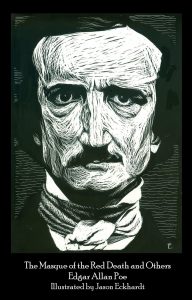
With that in mind, today we face up to the mystery of one of M R James’s night-monsters – bird or demon? – and in the next few days we’ll highlight a jolly nice-looking new version of Poe’s work, illustrated by Jason Eckhardt. For now, the wonders of translation…
M R JAMES AND THE OWL
Musing on Poe, and remembering a classic James short story, it struck us that if ravens are strange, the screech owl is stranger. So we drifted into one of those impromptu pieces of complicated trivia, for idle amusement.
This one revolves around a single translated word, ‘lamia’, and its role. You may remember the famous inscription mentioned in M R James’s story ‘An Episode of Cathedral History’, published in the Cambridge Review (1914) and reprinted in A Thin Ghost and Others (1919):
He accompanied them with a sketch of the tomb and a copy of the short inscription on the metal cross which was affixed at the expense of Dr. Lyall to the centre of the northern side. It was from the Vulgate of Isaiah xxxiv., and consisted merely of the three words —
IBI CUBAVIT LAMIA.
The inscription is widely taken to mean ‘a night-monster lives/lived here’ – here being within the old tomb. What it truly means is one of those wonderful mysteries of language and the art of translation.
The direct source is the Latin Vulgate Bible (Isaiah 34:14):
et occurrent daemonia onocentauris et pilosus clamabit alter ad alterum ibi cubavit lamia et invenit sibi requiem
And demons shall meet with monsters, and one hairy one shall cry out to another; there the lamia has lain down and found rest for herself.
The funny thing about the Vulgate (late 4th/early 5th CE) is that it was largely the work of Jerome (later St Jerome), a Greek who turned from the Septuagint Greek translation of the Bible and, around 390 CE, began his translation to Latin from the Hebrew, despite being only a moderately competent Hebrew scholar.
We can assume that in the Vulgate, Jerome was referring to one of the mythic female monsters of the Greeks, the lamiai. These were considered part of a wider class known as empousai – female supernatural creatures who seduced young men and/or ate young children.
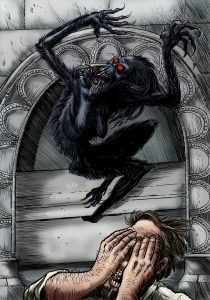
Extra Fun – According to the 1906 Jewish Encyclopedia:
“Arabic translators render the word in Isaiah 34:14 by ‘ghul’, which is identical with the ‘lamia’ of the Vulgate.”
See our series on the true origins of the ghul/ghoul myth here:
http://greydogtales.com/blog/ghoul-versus-ghul-a-myth-returns/
The Lamia
Note that when using the uncapitalised term lamia, writers were distinguishing the general creature from THE Lamia, a vengeful figure from Greek mythology beloved by Zeus, whose children were destroyed by the jealous goddess Hera.
Diodorus Siculus, on the other hand, preferred to place the original Lamia in a historical context, saying that she was a real woman, a wild and beautiful queen, living in a mountainous area of Libya, who lost all her children. He considered her more of a bogeywoman figure:
She was crushed by her suffering and became envious of the fertility of other women. So she commanded her men to snatch the children from their mothers’ embraces and kill them at once. And so it is still now in our age the story of this woman is kept alive with her mere name and is absolutely terrifying for them.
Diodorus (c.30 BCE)
Jerome, as he worked on the Vulgate, would likely have known both the literary references and the folklore concerning the lamia and the empousai, such as mentions in the works of Philostratos. From Philostratos’ Life of Apollonius (written between 217 and 238 CE):
Having passed the Caucasus our travelers say they saw men four cubits height, and they were already black, and that when they passed over the river Indus they saw others five cubits high. But on their way to this river our wayfarers found the following incidents worth of notice. For they were traveling by bright moonlight, when the figure of an empusa or hobgoblin appeared to them, that changed from one form into another, and sometimes vanished into nothing. And Apollonius realized what it was, and himself heaped abuse on the hobgoblin and instructed his party to do the same, saying that this was the right remedy for such a visitation. And the phantasm fled away shrieking even as ghosts do.
(F.C. Conybeare translation, 1911/12)
Thus far we might conclude that the Southminster Cathedral of M R James had at some point acquired a malevolent female spirit, a true lamia who fed on young men and children, or some combination thereof, well known to the Greeks. However, no folk are consumed in the story, and another notable attribute of many lamiai is their unpleasant smell, which isn’t mentioned. Let’s look further…
The Trouble with Lil
The original Hebrew word in the passage is Liyliyth or Lilith, a Jewish demonic spirit whose legends evolved through centuries of Hebrew demonology. As with the Lamia, Lilith has been given rather negative qualities, including being a seductress of young men and one who steals children, especially babies. So Jerome’s translation to ‘lamia’ follows, in that sense.
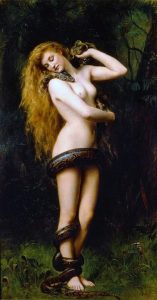
But… going even further back, in Mesopotamian lore lili and lilitu refer to night or wind spirits which could bring disease. The male version is lilu (Gilgamesh’s father was described as a phantom or lilu):
The Lilu who wanders in the plain.
They have come nigh unto a suffering man on the outside.
They have brought about a painful malady in his body
Rawlinson, Cuneiform Inscriptions of Western Asia (1891)
We like this, because at no point are the Greek lamiai associated directly with disease. Consider again M R James’ tale:
The season — it was a hot summer — turned sickly on a sudden. Dr. Ayloff was one of the first to go, with some affection of the muscles of the thorax, which took him painfully at night. And at many services the number of choirmen and boys was very thin.
And
The season was undoubtedly a very trying one. Whether the church was built on a site that had once been a marsh, as was suggested, or for whatever reason, the residents in its immediate neighbourhood had, many of them, but little enjoyment of the exquisite sunny days and the calm nights of August and September. To several of the older people — Dr. Ayloff, among others, as we have seen — the summer proved downright fatal, but even among the younger, few escaped either a sojourn in bed for a matter of weeks, or at the least, a brooding sense of oppression, accompanied by hateful nightmares.
Does this mean that we’re talking about a Sumerian demon on the loose, bringing sickness in the night? Etymology goes mad here. Put simply, there appear to be far too many words rooted lil- across the historic Mesopotamian languages and Hebrew to be sure which is related to which, and there are arguments about whether or not the Sumerian terms relate directly to the Hebrew Liyliyth.
Some prefer to look to the lilin, who were night-spirits in both Mesopotamian and Hebrew lore. Lilin were said to be of human shape (but possibly with wings). If lilin are seen as the sons and daughters of Lilith, then this option opens up M R James’s Solomonic influences (see also his story ‘Canon Alberic’s Scrap-book’), for the lilin were said – in variants of the Book of Esther – to have danced at King Solomon’s command.
Or we could stick with Lilith herself:
The first question which Solomon asked Beelzebub was the very natural one whether there were any female demons. And, by way of answer, one was brought before him, whom we recognise as the Greek Empusa, and have met in the Frogs of Aristophanes. She is here called Onoskelis; and it may be remembered that Empusa had the leg of an ass or mule. In the long account of herself which she gives to Solomon we see a good many traits which connect her with the Lilith of Jewish mythology.
The Testament of Solomon (review of), M R James, Guardian Church Newspaper (1899)
Note: More on M R James, the Testament and other demons can be found on Rosemary Pardoe’s excellent ‘Ghosts & Scholars’ site via http://www.users.globalnet.co.uk/~pardos/ArchiveSolIntro.html
There’s that Greek empusa – or empousa – again, but as an individual, not a class. For other detail on Lilith to help us out, we might consider Jewish folklore:
The superstitions regarding her (Lilith) and her nefarious doings were, with other superstitions, disseminated more and more among the mass of the Jewish people. She becomes a nocturnal demon, flying about in the form of a night-owl and stealing children. She is permitted to kill all children which have been sinfully begotten, even from a lawful wife.
Grunwald, vol. 62 Mitteilungen der Gesellschaft für Jüdische Volkskunde
A night-owl, eh?
Owls of the World
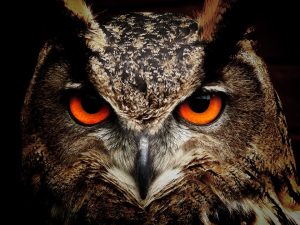
Many will know that the King James Bible (early 17th century) presents the crucial Isaiah passage as:
The wild beasts of the desert shall also meet with the wild beasts of the island, and the satyr shall cry to his fellow; the screech owl also shall rest there, and find for herself a place of rest.
The screech owl? ‘Ibi cubavit lamia’ is about bird-life?
The King James Version of the Old Testament was based on Blomberg’s Rabbinical Bible, which included commentaries by the famous Abraham Ibn Ezra (1089–c.1167), who is said to have interpreted the Hebrew word as meaning the screech owl. Ibn Ezra was reputed to be a bit of a rationalist, and not much given to believing in literal demons, so seems to have avoid the Lilith myth issue, although the KJV may have acknowledged the demon connection when it suggests “night-monster” in the margins. But screech owl it is, in print.
Now, the true screech owl is a New World bird, which means it was unlikely to have been found wandering around deserts in the Middle East. Could the bird in question have been a species of the scops owl type, closely related to the screech owl, whose range does include the Levant. Well, no, because peculiarly, neither of these two types of owl screech at all, whatever you call them.
So perhaps we should turn to the barn owl (Tyto alba) as the main suspect, as this does have a shrill, scary call and was indeed known as the screech owl in some parts of Europe. But… barn owls tend not to be found in desert regions.
On the other hand, the pharaoh eagle-owl is a relatively common species of owl found in deserts, including all Biblical territories, and would be ideal for the terrain. Unfortunately the pharaoh eagle-owl does not appear to screech.
As Ibn Ezra was widely travelled throughout the Mediterranean countries, even reputedly coming to England, he would have been familiar with the barn owl. He might well, from his time in Palestine and North Africa, have known the pharaoh eagle-owl. Did he conflate two owls for literary effect, or did he have something else entirely in mind? It’s a bit late to ask him, sadly.
We can’t even pin down that darn owl.
The State of the Lamia
So, going through a dozen translations and more, there is no agreement as to what ‘ibi cubavit lamia’ means. Not only do translators vary between using lamia, night-monster, screech owl, Lilith and more, for one final added delight, the New World version used by Jehovah’s Witnesses takes its own ornithological route:
Yes, there the night-jar will settle and find a place of rest.
From M R James’ original descriptions, we don’t think it was a night-jar.
‘Come, you must have seen it,’ he says. ‘Didn’t you see? A thing like a man, all over hair, and two great eyes to it?’
‘Black it was,’ he’d say, ‘and a mass of hair, and two legs, and the light caught on its eyes.’
The gender of the thing is not discussed in the story, we’re afraid – assuming ‘like a man’ simply refers to general anthropoid appearance – but on that gender issue, Monty gives us another direction when he mention the cries in the night:
‘You go and look it up.’ I wanted to know what he was getting at myself, and so off I ran home and got out my own Bible, and there it was: ‘the satyr shall cry to his fellow.’ Well, I thought, is that what we’ve been listening to these past nights?
Satyrs are notoriously male, of course, but this would rely on the King James Version – many translations use ‘goat’, ‘hairy goat’ or ‘goat demon’, without specified gender. We see M R James’s reference in the conversation as no more than a reflection on mournful sounds, an association by the speaker, not indicative of the creature’s true nature.
That it was ‘all over hair’ is problematic for a number of our options – if lamiai are anything apart from always female and sometimes hideous, they are referred to as having scales or other serpentine qualities.
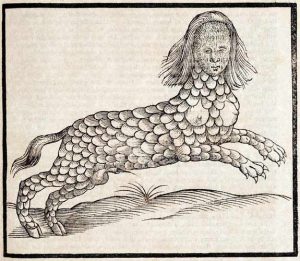
And owls are not hairy, though witnesses in the story might have mistaken a fine coat of feathers for such. Was the creature’s appearance due to the hair of one of Lilith’s lilin children having grown long and unmanageable?
Or – reaching back to the satyr if we must pursue the hairy matter – this is a translation of the original se’irim, a class of Hebrew demon of the hairy variety, which haunted woods, wasteland and deserts.
The wilderness as the home of demons was regarded as the place whence such diseases as leprosy issued, and in cases of leprosy one of the birds set apart to be offered as an expiatory sacrifice was released that it might carry the disease back to the desert (Lev. 14:7, 52)
Jewish Encyclopedia (1906)
Disease once more rears its head – not a Greek satyr, but the earlier Hebrew form. Which would imply that the lamia (in witch, demon, serpent or other form) has nothing to do with the story except that she/it happens to be part of the passage drawn on for the inscription. In which case
IBI CUBAVIT PILOSUS
would have been a bastardised quote but a more appropriate one. And maybe the bird released was an owl? Let’s not go there.
In Non-Conclusion
We must ask, after all that, was the inscription over the tomb at Southminster Cathedral meant to indicate:
a) The resting place of a Hebraic, disease-bearing, night-demon owing its powers to its origins in the Sumerian wastelands?
b) The home of a depressed, misplaced Greek lamia, who no longer had the will to devour young men and children directly?
c) The lair of one of Lilith’s last surviving offspring, no longer under Solomon’s control but still drawn to places of Abrahamic worship?
d) Occupation by a very large, annoyed member of the order Strigiformes, that is to say, an owl who was looking for somewhere dark and quiet to have a kip?
Our final alternative is that, as the inscription ‘ibi cubavit lamia’ was place there by Canon Lyall, who had earlier quoted Isiaiah 34:14, and was erected AFTER the whole affair was over, it was merely a whimsy of the good canon. It was never intended to be definitive of anything. It had stuck in Lyall’s head, and was as good as quote as any with which to mark the tomb. A mood, not a monster.
Oh, and no, we don’t think it was a vampire.
That beautifully illustrated Poe book, which we’ll say more about next time, is available now:
UK Amazon – Masque of the Red Death
I just read this story and immediately found your post upon searching where I’d heard of a lamia before. Thank you for this thorough breakdown! I found it fascinating. I’m inclined to agree, after reading this, that Lyall was having a bit of a laugh with his sign. It does sound very much like it could have been an owl all along, but I love how open-ended it is.